Weathering
There are two competing forces working at the earth's surface.
One tends to build things up and the other tends to break things down.
They are:
Plate Tectonics
(building things up) - driven by heat generated inside the earth trying
to escape to the surface
The Atmosphere & Gravity
(tearing things down) - the atmosphere is driven by solar energy
In this unit, we will concentrate on the forces tearing
down things. We start with weathering!
Weathering: The
disintegration and decomposition of rock at or near the surface of the earth
(breaking up rocks).
-
Mechanical Weathering (using direct force)
-
Frost Wedging (also known as frost action)
-
This is the most important mechanical weathering process
of them all!
-
When water freezes it expands 9% in volume due to the unique
way water molecules line up when crystallizing (forming a hexagon)
-
It is most active when the temperature frequently crosses
32 degrees (late fall to early spring in Wisconsin, also in mountains)
-
examples are potholes, cracks in sidewalks, rocks found on mountain
roads etc.
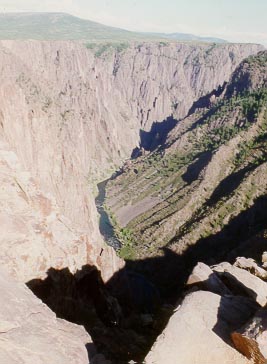
Can you guess how a valley wall could get this shape?
(One side is very steep and the other has a gentle slope)
-
Internal Stress
-
Unloading - removal of overlying layers make the rocks below expand. This
is what happens when you get up from the couch ... the padding expands and
returns to the original shape.
-
Exfoliation - chemical changes produce volume changes. This tends to make
rock peel away in layers in a process geologist call sheeting.
-
Together these two effects can make rock peel away like an
onion as in Half Dome (Yosemite National Park)
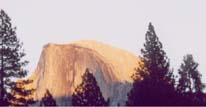 Half Dome
Half Dome
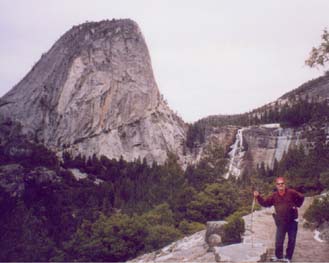
This is an example of an Exfoliation Dome (Yosemite). A granite
chamber formed deep underground. As overlying layers were removed,
the rock weakened in layers which follow the domes present shape.
This dome is constantly being "peeled" off like an onion (sheeting). Note the
cool dude enjoying all this beauty.
-
Thermal Expansion - sudden heating of rock
(forest fires). The rock cracks due to internal stress (like dropping
an ice cube in water).
-
Crystallization of Salts - dissolved salts expand
as they dry and crystallize in small cracks.
-
Life - Root wedging, burrowing animals, man. Also bacteria
and decaying plants produce acids which chemically destroy rock.
-
External Forces (Abrasion, shock, external stress)
-
Glaciers
-
Waves - abrasion by sand motion & "punch" of waves against
rock (up to 6000 pounds/square foot)
-
Sandstorms - Arches in Utah
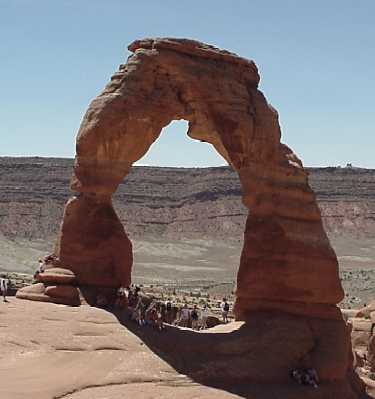
Ask me about a great field
trip offered by Dr. George Stone and Dr. Bob Helwig at MATC.
-
Faults (Tectonic Activity - plates pushing together, pulling
apart, or rubbing across each other)
-
Streams - the force of running water & the sediments it "drags"
with it does a VERY efficient job of weathering rock. One example
are the "pits" created by swirling sand as water runs over a granite block
in Johnson Shut-In
State Park, MO.
-
Earthquakes - shock wave weakens adjacent rocks (after shocks)
-
Pressure of moving magma as it rises and tries to escape to the surface
-
Collisions - falling rock hitting other rock (rock slides)
& meteor impacts
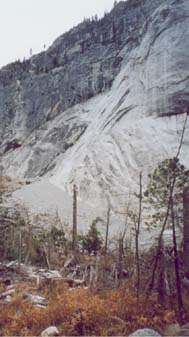
Rock Slide in Yosemite (July 10, 1996) |
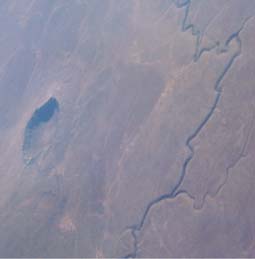
Meteor Crater AZ |
-
Chemical Weathering (dissolving rock with
chemicals)
-
Water is the key! Therefore,
chemical weathering is most active in warm, moist
climates.
-
Carbonic Acid - Carbon dioxide (CO2 )
dissolved in water forms H2CO3 (the same stuff you
find in most soda). This produces a weak acid "rain" which attacks
rock as it percolates through the ground.
-
To a lesser extent, sulfur emissions from the burning of fossil fuels also
produce acids (sulfurous & sulfuric acids) which can effect areas far from the
source of their emission.
-
This attacks and dissolves limestone and marble (Calcite
CaCO3) creating caverns and destroying monuments - such as
Cleopatra's
Needle (when it was moved to NY)
-
This acid attacks the potassium feldspar which is a common
mineral in granite. The result is a fine clay mineral (Al2Si2O5(OH)4).
This gets transported easily in water and deposited as sediment.
The resulting rock forms shale.
-
The other by-product of this chemical weathering is bicarbonate
... a dissolved form of carbon which will become important in the next
unit when we discuss the carbon cycle.
-
The quartz in the granite is less resistant to chemical weathering
and is freed as sand. It, too, gets washed to the sea forming beaches,
dunes, and perhaps sandstone.
- Organic chemical weathering - acid can also be formed by organisms
such as bacteria, lichens (see yellow patches in the
image below), mosses and decaying plants. This can be the first stage of breaking up a rock
because these tiny organisms create the first tiny cracks in a rock. Once
formed, frost wedging can take over and make the cracks bigger.
Here are some other ways rocks may be chemically weathered
(just in case you were interested)! Please just skim over the list below.
(until you get to the horizontal line)
-
Oxidation - reaction with atmospheric oxygen to form rust.
Mars looks red because most of the oxygen in its early atmosphere reacted
with the surface rocks.
-
Hydration - Hydration is the combination of a solid mineral
or element with water. When the water molecules are chemically bonded to
the mineral, the size of the chemical structure is increased, thereby making
a softer, more stressed, and more easily decomposed mineral. Sub-surface
hydration probably produced England's granite Tors.
-
Solution - water dissolves rock salt and to a lesser degree,
other minerals.
-
Hydrolysis - Hydrolysis is the process of minerals reacting
with water to form hydroxides, which usually are more soluble than the
original mineral. Hydrolysis is one of the most important weathering processes
causing soil profile changes.
-
Reduction - Reduction is the chemical process in which electrons
are gained. In soils, reduction usually takes place when oxygen is scarce,
as in stagnant water conditions. Reduction in minerals may result in electrically
unstable compounds, more soluble ones, or more internally stressed ones,
which eventually decompose more rapidly.
-
Rates of chemical weathering vary greatly from place to place, depending on:
-
Types of chemical agents and minerals which are available
-
Climate (warm, moist vs. cold, arid)
-
Surface Area (the smaller the better)
-
Because edges and corners of a rock have a higher surface
area/volume ratio. Chemical weathering is most efficient there. This
means a rock with sharp edges and corners soon will weather to a round
flat surface. This is known as spheroidal
weathering. Examples are most rocks you find on a beach
or the Elephant Rocks in MO.
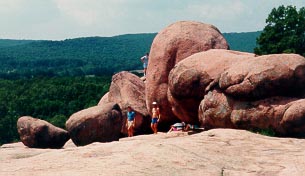
Elephant Rocks State Park, MO (Check out the cool dude in the
blue shorts)
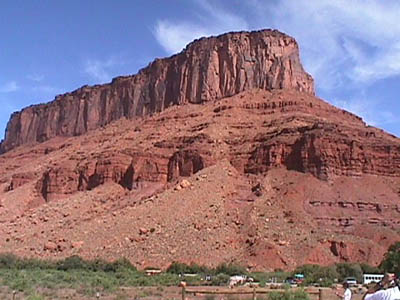
This is a mesa (Spanish for table) ... formed because a resistant layer
of sandstone acts like a "cap" protecting the weaker rock below.
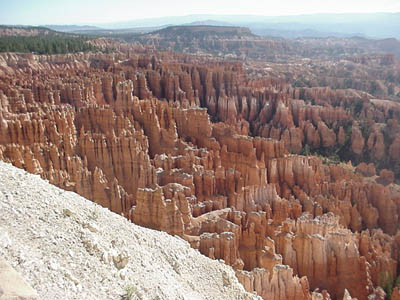
This is Bryce Canyon (Utah)... very pretty! This rock is very
easily weathered and eroded (as much as several feet per year) ... so get
there before it's gone!
Some General Ideas about Weathering
- All rock types are subject to mechanical weathering once they are
exposed to the earth's surface but the degree can vary depending on the
hardness of the rock.
- There is a much greater variation in the amount of chemical weather
of rocks. Some rocks are highly resistant to chemical action - quartz
for example. Other rock types (basalt) are highly susceptible to
chemical action.
- Both actions (mechanical and chemical) will work together to break up a
rock. For example, once lichen create small pores in a rock (chemical),
frost action can enlarge the crack. Once the rock is broken into smaller
pieces, the increase in surface area allows a dramatic increase in chemical
attack.
ŠJim Mihal 2004, 2006 - all rights reserved

 Half Dome
Half Dome







